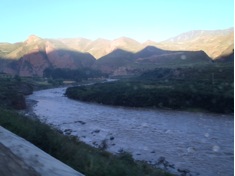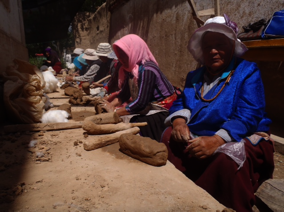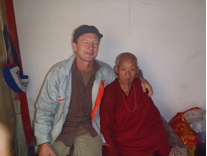Making Buddhas By The Yellow River
Waking up in the drab, decaying, government hotel could have dampened any solo travelers spirits. The CCP standard hotel room layout (it was exactly the same as our hotel in Tong ren) has been left behind in China’s reinvention of itself. The bath-tub was rusty, half the lights didn’t work, nor the television, there was no towel and the pillow was packed with a grain of some sort. However the massive curtainless window offered a view to make up for all the failings. Beyond the mix-up cityscape of concrete , mud and brick, interspersed with random pagodas, incinerator chimneys and TV aerials , the mountain range across the river was illuminated by the rising sun, bringing out all the golds, ochres, pinks and reds of the ravined landscape. The tops of the distant mountains were layered with an overnight snow fall. A classic high Asia view.
It is great fun to be on random free flow for a change, not really knowing where I am, no map, nor barely a word to communicate with…you never know what will come up and where whatever does come up will lead to. A lovely feeling for sure. In this frame of mind, I set out to see the Confucian temple that Guide was so proud of. (Guide is a city south of Xining, not from the source of the Yellow River.) The first impression was it’s toned down color scheme, compared with all the overtly bright Tibetan temples. The site was obviously a well kept tourist attraction, but being early I had the place to myself. There is a very tranquil atmosphere in these temple compounds, the layout creates neat courtyards and shaded spaces, some with trees growing in the middle, others with big iron incense burners blessing the sacred place with scented smoke. The countless large “sacred” statues inside the temples, failed to convince me somehow…after the calming elegance of the various Tibetan Buddha’s I have seen, these Confusion deities came across as over painted, gaudy and grotesque in comparison. I do need to know more about them though to make any informed comment. I was intrigued to see one of them holding forth the familiar Masonic symbol of a golden triangle with an eye in it. Ma wang yé, I found out subsequently, is a god of war and fire.
From the top of the pagoda I spotted a little veggie garden, for the temple residents, surrounded by beautiful flowers and a collection of different varieties of sunflower. I later snagged some dry heads to try at home….with the permission of the sweet old lady gardener of course. I miss my garden!
My wanderings then took me down some quiet alleys between the rammed-earth walls. I was vaguely heading to a big stupa I had spotted from the pagoda. This was the old part of the town, with a center less of maze of ally’s, unpaved streets and shaky old wooden doors. One thing struck me here… Its amazing the shit collection systems in these old towns. I passed a few really basic ones! The most striking one, for the passing pedestrian, must have comprised of a raised platform behind the earthen wall, where you squat inside the yard or house. Then on the alley or public (my) side of the wall there is a street level cubbyhole, where the shit lands! It makes obvious sense really in a “not my problem, after the act” world! Or is it the caring sharing world that is designed to make it much easier for a shit collector to shovel it into his cart to carry to the gardens! You can come and get it any time. I came across another one on the same principle in the ancient house of two old gentlemen wood-block carvers we visited in Tong ren. They had a two level courtyard house, with the upper story being partially roof terrace. At the top of the steps to the terrace, open to the sun or moon, was a rough bricked squat slot cut into the rammed earth. The shit obviously dropped down to a special collection room below …cunning, convenience eh? These ancient systems certainly save a lot of bother with plumbing and septic tanks etc!! I am not saying this will work for all, nor are all Chinese toilets this ingenious. Don’t worry, the plumbed ceramic throne is in steady use by the millions of high-rise dwelling Chinese…though I might guess the ceramic squat and it’s lesser variations are still the people’s choice, certainly in the public sector. After 5000 years of cultural development, the old adage “If it ain’t broken don’t fix it” holds (and squats) strong. Ok … sidetracked a little there, but it’s an important point of interest to us all.
My attention was soon caught by the sound of repetitive dull pounding, coming from a shady area across a mud drain. It didn’t take long for me to realize I had stumbled upon a group clay-working operation, nor for me to decide where I was going to spend the rest of the day. I was immediately waved over the drain by a big smiling Tibetan man, who was obviously happy to include me in their group that was gathered, at what transpired to be the back of their temple. The thudding was coming from a line of about 15 elderly Tibetan women, all in their traditional dress, who were sitting on low stools along a ledge pounding at large lumps of clay. As they were pounding they were mixing in handfuls of cotton and an unidentified red powder into the clay.
I had encountered this practice a couple of days before when meeting a Tibetan thanka painter and clay Buddha sculptor in Tong Ren. The cotton binds the clay well as it dries, as these works are not fired. The ladies were have a great time (and good exercise) giggling and chatting away. Under a shade cloth around the corner was the continuation of this happy production line. Younger women where gathering the pounded clay and slapping it into handleable rectangular blocks, which were then passed to a couple of the key strong old men to be rammed into two part brass Buddha moulds. With help from an assistant, who would brush a few strokes of melted Ghi (yak butter) into the mould, the mould-masters would sandwich the clay between the two parts and hammer the top mold down with a lunking log mallet and clamp it shut with iron rings, squeezing clay out of the sides. Everything was done with such laughter and positive spirit through out the all age crew. The mold was then turned head down and the pointed end of the log mallet was used to force the clay further into the mold and add more. Once satisfied it was full, the master would then ram a thin bamboo into base, making a shaft to the Buddha’s head. He would then produce from his pocket a selection of tightly bound cloth rolls printed with mantras on them and slot them into the shaft, two per Buddha, and different prayers for different models. To cap off this ancient mystical juju, he would sprinkle in a few grains of wheat and some other seeds, then seal the hole and pop the statuette out of the mold to be passed down the line for trimming and cleaning. This is where I was slotted into the process! … though not until after I was invited to a delicious communal lunch, scattered on our haunches around the small temple yard. Noodles, veg and steamed bread rolls. The I-pad and I introduced ourselves to the intrigued group and after a picture viewing session, a few simple gestures, and willing smiles, it was understood that I was here to work with them. No problem….
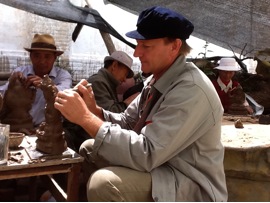 After lunch I was duly given a seat under the shade cloth, given some tools and a steady supply of Buddha’s, there I spent the rest of the day with the trimmers, giggling, scraping and smoothing the shiny Ghi-soaked statues. What a peaceful time, quiet, semi-creative, meditational work Someone put on a recording of some singing and chanting. A well behaved baby boy who’s mother was working opposite me would come and collect the scrapings and carry them back to the elderly pounders to be recycled. People would come and go, stand and look, take pictures of me with their cell phones, laugh and swap roles between the chores, or just sit and chat. All the while we plugged out a whole heap of Buddha’s that where dutifully carried away to the drying racks in one of the ramshackle rooms next to the leading monks quarters. As for production line efficiency, inclusive of spiritual contentment goes, it ranks as the best I have encountered. There was no suggestion that anyone was getting paid much more than lunch….no boss bossing, though at times a few quieter more important looking monks came by to see how things were going. One of them had an interesting bound set of architectural plans, for the temple expansion. Other monks would drop in and out of the production. When 4’o clock came the gathering began to break up quietly. A few of the girls who had said nothing to me all day surprised me with a perfect English “see you tomorrow !”…and more giggles.
After lunch I was duly given a seat under the shade cloth, given some tools and a steady supply of Buddha’s, there I spent the rest of the day with the trimmers, giggling, scraping and smoothing the shiny Ghi-soaked statues. What a peaceful time, quiet, semi-creative, meditational work Someone put on a recording of some singing and chanting. A well behaved baby boy who’s mother was working opposite me would come and collect the scrapings and carry them back to the elderly pounders to be recycled. People would come and go, stand and look, take pictures of me with their cell phones, laugh and swap roles between the chores, or just sit and chat. All the while we plugged out a whole heap of Buddha’s that where dutifully carried away to the drying racks in one of the ramshackle rooms next to the leading monks quarters. As for production line efficiency, inclusive of spiritual contentment goes, it ranks as the best I have encountered. There was no suggestion that anyone was getting paid much more than lunch….no boss bossing, though at times a few quieter more important looking monks came by to see how things were going. One of them had an interesting bound set of architectural plans, for the temple expansion. Other monks would drop in and out of the production. When 4’o clock came the gathering began to break up quietly. A few of the girls who had said nothing to me all day surprised me with a perfect English “see you tomorrow !”…and more giggles.
By this time I had already been invited to spend the night, so a couple of the friendly mould-masters showed me to an empty bed room in the temple yard. Don’t imagine anything grand here, it is a small set up, there were shrubby unkempt trees, and old incense burner, a pile of brass conduit pipes and prayer money littered on the ground, then a couple of steps leading to the curtained off inner sanctum. I sat in the kitchen, which faced into the yard, drinking cha with an old monk called Kung Cho Jan Su who had taken a fascination to me and my I-pad picture show.
There was little we could talk about, my Tibetan being a lot worse than my Chinese (!) so I entertained him …and hopefully flattered him by sketching him. He was very relaxed and happy to sit quietly with me, enjoying the space-time continuum. He had a quality twinkle in his eye and reminded me a lot of my dear Carib Indian friend Chalo, on one of his more sober reflective days.
It was peaceful place to sit around as the day cooled off. The others had all gone home except a few lamas and monks who wandered in and out of the kitchen. One of these was a lad who painted the Buddha’s after they had dried, he apparently did this inside the new Stupa that was nearing completion next to the old monastery we were in. We made a plan that I should help him tomorrow.
Before it got too late I went for a walk down to the great Yellow river, the mother river of China. It is still young in these parts, but not unimpressive all the same. There is a new walkway under construction, across the wetland between the stupa and a huge project being worked on by the river. This structure comprises a large hall, maybe for conferences or worship I am not sure. Across from the hall is a completely untraditional, Disney-like structure of a golden Dharma wheel maybe 100 foot high, coming out of a massive lotus flower. I could not get inside this fantasy building as even in the fading light the place was swarming with workers, cutting marble slabs, running cables, measuring, sweeping and banging. The shining metal on the wheel was an extravagant display of beaten yellow copper, from the top of which in all directions extended 8 dragon heads. I later met the man who made them at the workshops of Tar se, so got a little low down on what is going on here. It is weird and interesting. I haven’t understood everything yet, but by the scattered accounts I am getting and from what I saw, the monasteries around Qinghai are undergoing serious expansion . The money is coming in from presumably devout Hong Kong and Taiwanese businessmen, who may well see this as a chance to secure a great future in the next life….or perhaps more realistically are looking for a secure and steady return on their investment from the millions of devout Buddhists in these parts. It is slightly bizarre and I don’t know enough about it to give full judgment, but by appearances it has the look of cynical exploitation of the ancient and deep-seated religiosity of the Tibetan people.
 There are of course other sides that the mighty lamas must have considered in their council. In the past the monasteries of Tibet and Qinghai had operated as the most powerful and all encompassing institutions in the land. They were the bank, the government, the church, the factories, the super-market etc all rolled into one. Essentially the financial, political, agricultural, social and spiritual centre-points of Tibetan society… not dissimilar to the abbeys of medieval Europe, except the Tibetan ” king” was a supreme being and reincarnation of Buddha himself. This explains why the Chinese were so preoccupied with their total destruction during the invasion and occupation of Tibet in the 1950s through to the Cultural Revolution. By expanding and revitalizing these monasteries the lamas must have some vision of restoring their importance in society. However my skeptical mind tells me there must have been some tactical arrangement made between the lamas and Chinese government, aside from the obvious fact nothing in China, or Tibet for that matter, can go on without the governments knowledge, there must have been some agreement on the modus operandi of this resurgence of the religious institutions. I could not tell you whether there are restrictions on the monks and lamas as to how there are to act, or whether they have to tow an acceptable party line. But my observations of the iconography employed in the new structures can only suggest there has been an agreed merger of Tibetan traditional styles and classic Chinese, or Confucian, imagery. I can only really base this on my visit to Guide, where I helped make the Buddhas for the new stupa and saw the new Dharma wheel by the river, but I know there are other huge monastery expansion projects else where in Qinghai and Tibet. These projects are certainly giving a boost to the local construction industry and as I discovered later, keeping a lot of artisans in the region very busy.
There are of course other sides that the mighty lamas must have considered in their council. In the past the monasteries of Tibet and Qinghai had operated as the most powerful and all encompassing institutions in the land. They were the bank, the government, the church, the factories, the super-market etc all rolled into one. Essentially the financial, political, agricultural, social and spiritual centre-points of Tibetan society… not dissimilar to the abbeys of medieval Europe, except the Tibetan ” king” was a supreme being and reincarnation of Buddha himself. This explains why the Chinese were so preoccupied with their total destruction during the invasion and occupation of Tibet in the 1950s through to the Cultural Revolution. By expanding and revitalizing these monasteries the lamas must have some vision of restoring their importance in society. However my skeptical mind tells me there must have been some tactical arrangement made between the lamas and Chinese government, aside from the obvious fact nothing in China, or Tibet for that matter, can go on without the governments knowledge, there must have been some agreement on the modus operandi of this resurgence of the religious institutions. I could not tell you whether there are restrictions on the monks and lamas as to how there are to act, or whether they have to tow an acceptable party line. But my observations of the iconography employed in the new structures can only suggest there has been an agreed merger of Tibetan traditional styles and classic Chinese, or Confucian, imagery. I can only really base this on my visit to Guide, where I helped make the Buddhas for the new stupa and saw the new Dharma wheel by the river, but I know there are other huge monastery expansion projects else where in Qinghai and Tibet. These projects are certainly giving a boost to the local construction industry and as I discovered later, keeping a lot of artisans in the region very busy.
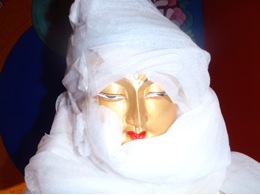 After a peaceful nights sleep, snug in borrowed bedding, I breakfasted on more steamed buns, cha and grapes. It was time for some Buddha painting.
After a peaceful nights sleep, snug in borrowed bedding, I breakfasted on more steamed buns, cha and grapes. It was time for some Buddha painting.
The stupa at Guide has very out-of-place stone relief carvings of distinctly Confucian gods on every corner of the structure, the doors are over-ornately decorated with Chinese dragons and inside every square inch of wall space and ceiling space on all three floors was painted in a hybrid Tibetan style, with large panels of totally out of place Chinese classical ink landscape paintings and kitsch bamboo and tiger scenes. Visitors were not allowed into this nearly , but not quite finished sanctuary. I was in with the Buddha painter though, who spends his whole day alone on the second floor, painting the Buddhas , by the light of one bare light bulb, so I got to prowl around a bit. It was quite spooky, alone, by the light of my cell phone torch, feeling my way around this sacred space, coated with newly settled construction dust. The top floor was incredible, there was room after windowless room full from floor to ceiling with stacks of the traditional long-book religious texts, all wrapped in silk sleeves. Not all of the stacking was complete and countless cardboard boxes lay around ripped open , the texts scattered carelessly over the floor. These texts will most likely never be read, nor many of the 1000 plus clay Buddhas, that my friend was diligently lining the shelved walls with, will ever been seen by the lay people. But they are considered the essential core of a stupa that cannot be counted as sacred with out them. Back out in the light I walked around the balcony where regularly spaced niches housed yet more Buddhas, these ones large highly polished brass ones, but they hadn’t been unpacked from their wrapping yet, except for a few hands and the occasional faces poking through, they looked like Muslim ladies with glamourous gilded eyes peeking through their scarves.
My time was running out, so I went back inside to help my friend paint some blue trim on a dozen or so more Buddhas. I suggested he open the door and use the natural light, instead of sitting by the glaring light bulb. He took to that idea! After a while the road beckoned me and I reentered the ever mobile crowds of the Chinese world, hitching a ride on an electric three- wheeled bike to the bus station, where I didn’t have to wait long for a bus to take me to Qinghai Hu, the largest and saltiest lake in China.

